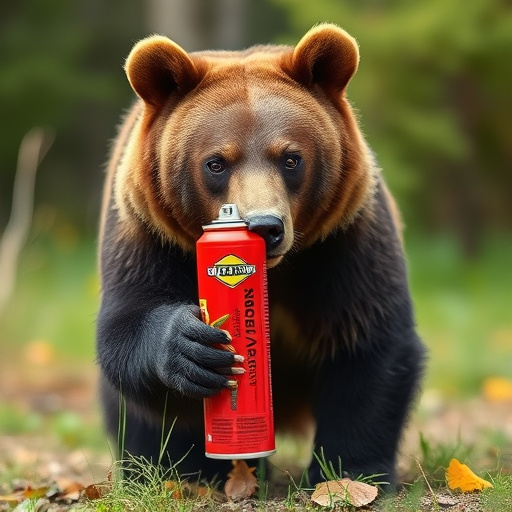Bear spray is an effective self-defense tool against bears when used correctly and tested according to Bear Spray Testing Safety Guidelines. Testing involves controlled settings with protective gear, focusing on understanding spray range, wind effects, and application technique. Adhering to guidelines ensures the spray's reliability while minimizing risks during bear encounters, considering it isn't foolproof against all bears. Regular training, proper disposal, and post-testing reviews are crucial for optimal use and safety in bear country.
Bear spray is a powerful tool for self-defense in bear country. Understanding its dynamics, safety measures, testing protocols, and stopping power factors is crucial for effective protection. This article delves into the science behind bear spray, offering comprehensive guidelines on testing safety to ensure maximum effectiveness. From pre-application preparation to post-testing care, we explore essential practices to enhance your survival chances in bear encounters.
- Understanding Bear Spray Dynamics
- Safety Measures Before Application
- Testing Protocols for Maximum Effectiveness
- Evaluating Stopping Power Factors
- Post-Testing Guidelines and Care
Understanding Bear Spray Dynamics
Bear spray, also known as bear deterrent or bear repellent, is a powerful tool for self-defense in bear country. Understanding how it works and following safety guidelines during testing is paramount. When sprayed directly into a bear’s face, bear spray creates an irritant that temporarily disables the animal, allowing time to escape or seek refuge. However, proper usage requires knowledge of the product’s range, effectiveness against different bear species, and the importance of aiming for the eyes and nose.
Adhering to Bear Spray Testing Safety Guidelines is crucial. This includes conducting tests in a safe, controlled environment, wearing protective gear, and ensuring adequate ventilation. It’s important to note that bear spray is not 100% effective, especially against large or aggressive bears. Therefore, users must remain alert, maintain distance, and consider carrying additional forms of protection for enhanced safety in bear-infested areas.
Safety Measures Before Application
Before applying bear spray, it’s crucial to understand and adhere to safety guidelines and testing procedures. Always conduct a practice test in a controlled environment to familiarize yourself with the spray’s range, wind conditions, and proper application technique. This ensures that when faced with an actual bear encounter, you can use the spray effectively while minimizing risk to yourself and others.
Additionally, ensure you are aware of local regulations and guidelines for bear spray usage, as these can vary based on region. Understanding the legal implications and safe storage methods for your bear spray is essential, particularly in areas where wildlife interaction is common. Following safety measures not only maximizes the stopping power of the spray but also promotes responsible wildlife management practices.
Testing Protocols for Maximum Effectiveness
Bear spray, a powerful defense against aggressive bears, is subject to rigorous testing protocols to ensure maximum effectiveness and user safety. These tests are conducted under controlled conditions, mimicking real-life bear encounters. The Bear Spray Testing Safety Guidelines stipulate specific parameters for these trials, focusing on factors like spray distance, accuracy, and duration of protection.
Professional testers use mannequins or trained volunteers equipped with sensors to simulate bear behavior, enabling them to measure the spray’s impact accurately. By adhering to these safety guidelines, researchers can guarantee that bear spray not only deters bears but also provides users with a reliable and safe defense mechanism in potentially life-threatening situations.
Evaluating Stopping Power Factors
When evaluating the stopping power of bear spray, several key factors come into play. Firstly, the concentration of capsaicin, the active ingredient responsible for the burning sensation, directly impacts its effectiveness. Higher concentrations typically mean more intense irritation and faster neutralization of the threat. Testing methods should adhere to recognized Bear Spray Testing Safety Guidelines to ensure consistent results.
Additionally, the spray’s range and pattern play crucial roles. A wide spray pattern covers a larger area, increasing the likelihood of impacting the bear’s eyes, nose, and mouth—the primary sensory organs involved in aggression. Moreover, understanding how different weather conditions, such as temperature and humidity, might affect spraying performance is vital. These factors collectively contribute to determining the optimal range and duration for successful deployment during an encounter with a bear.
Post-Testing Guidelines and Care
After conducting bear spray testing, it’s crucial to follow established safety guidelines for proper care and disposal. Always wear protective gear during the testing process to prevent any accidental exposure. The area where tests are conducted should be thoroughly cleaned to remove any residual spray, ensuring no trace remains. Disposal of used test equipment must adhere to local regulations, typically involving specialized hazardous waste facilities.
Regular training sessions on bear spray handling and application are essential for users to understand the product’s effectiveness and limitations. Post-testing reviews should focus on evaluating the spray’s performance, user feedback, and any potential improvements. This iterative process helps ensure that bear spray remains a reliable defense mechanism, promoting safety in areas where bears are present.
Bear spray, when used correctly, can be an effective defense against bear encounters. Understanding the dynamics of bear spray, implementing safety measures before application, adhering to rigorous testing protocols, and evaluating stopping power factors are crucial steps in maximizing its effectiveness. Post-testing guidelines and proper care ensure the product remains potent and ready for use. By following these Bear Spray Testing Safety Guidelines, individuals can better protect themselves in potential bear encounters, enhancing their safety and peace of mind in wilderness areas.
